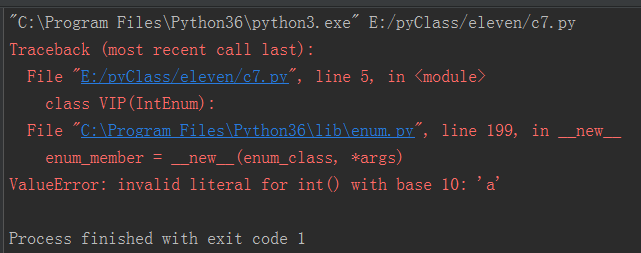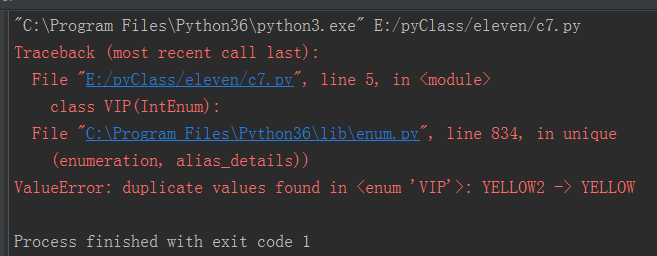一、枚举其实是一个类
现实世界中的“类型”,在计算机世界中如何描述?
常见的
1)用1、2、3..等数字表示类型
2)较好的做法是用字典表示
3)最好的是使用枚举
1 # coding=utf-8 2 from enum import Enum 3 4 5 class VIP(Enum): # 继承Enum类 6 YELLOW = 1 # 枚举类型建议使用大小 7 GREEN = 2 8 BLACK = 3 9 RED = 4 10 11 print(VIP.YELLOW)
1、python中,枚举的本质是类
2、使用时需要继承Enum类
3、类中定义一组常量,建议使用全大写字母表示
4、数字1、2、3其实没有意义,枚举的意义重在标识,不在取值。
二、枚举与普通类相比的优势
如果不使用枚举,如何表示类型
1)使用模块中的全局变量
yellow=1
green=2
2) 字典
{‘yellow’:1,'green':2}
3) 普通类
class TypeDiamond():
yellow=1
green=2
缺点:
1)可变,即可以在代码中轻易改变
2)没有防止相同标签的功能
现实中的‘类型’一旦定义不应该被轻易更改,但字典可以通过赋值改变类型,同样普通类也可以轻易改变类型。
字典和普通类允许变量(类型)相同
{‘yellow’:1,'yellow:2}
在python中没有真正的常量,在枚举中定义的类型不能被更改,且不能取相同的标记。
1)枚举的保护性
2)枚举的防重性
三、枚举类型、枚举名称与枚举值
1、获取某个枚举标签的值.value
2、获取某个枚举标签的名字.name
3、通过枚举标签的名称获取枚举的类型
4、枚举可遍历
1 # 获取枚举标签的值 2 print(VIP.YELLOW.value) 3 # 获取枚举标签的名字 4 print(VIP.YELLOW.name) 5 # 获取枚举类型 6 print(VIP.YELLOW) 7 for v in VIP: 8 print(v)
1 枚举值
YELLOW 枚举名称
VIP.YELLOW 枚举类型
四、枚举之间的比较
枚举支持的比较
1)等值比较
res=VIP.YELLOW==VIP.GREEN
print(res)
打印结果:False
2)身份比较
res=VIP.YELLOW is VIP.YELLOW
print(res)
打印结果:True
枚举不支持的比较
1)名称和值的比较
class VIP(Enum):
YELLOW = 1 # 枚举类型建议使用大小
GREEN = 2
BLACK = 3
RED = 4
res=VIP.YELLOW ==1
print(res)
打印结果:False
2)大小比较
res=VIP.YELLOW <VIP.GREEN
print(res)
报错:TypeError: '<' not supported between instances of 'VIP' and 'VIP'
3)枚举类之间的比较
class VIP(Enum):
YELLOW = 1 # 枚举类型建议使用大小
GREEN = 2
BLACK = 3
RED = 4
class VIP1(Enum):
YELLOW = 1 # 枚举类型建议使用大小
GREEN = 2
BLACK = 3
RED = 4
res=VIP.YELLOW ==VIP1.YELLOW
print(res)
打印结果:False
五、枚举注意事项
1、不能使用相同的标签
2、取值可以相同,但会作为别名,不能作为独立的枚举类型
3、枚举的遍历,取值相等时,不打印(无法访问)别名
1 # coding=utf-8 2 from enum import Enum 3 4 5 class VIP(Enum): 6 YELLOW = 1 # 枚举类型建议使用大小 7 YELLOW2 = 1 8 BLACK = 3 9 RED = 4 10 11 for v in VIP: 12 print(v)

4、如何遍历(访问)别名?VIP.__members__
1 # coding=utf-8 2 from enum import Enum 3 4 5 class VIP(Enum): 6 YELLOW = 1 # 枚举类型建议使用大小 7 YELLOW2 = 1 8 BLACK = 3 9 RED = 4 10 11 for v in VIP.__members__: 12 print(v)

六、枚举的转换
1、将枚举类型转化为数字
实际编码过程中,推荐:在代码中定义枚举类型,数据库中存储枚举值,通过枚举名称访问数据库中的枚举值
if a==VIP.YELLOW:#不推荐使用a==1
print(...)
if a==VIP.GREEN:#不推荐使用a==2
print(...)
2、将数字转化为枚举类型
a=1
print(VIP(a))
1 # coding=utf-8 2 from enum import Enum 3 4 5 class VIP(Enum): 6 YELLOW = 1 # 枚举类型建议使用大小 7 YELLOW2 = 1 8 BLACK = 3 9 RED = 4 10 11 a=1 12 print(VIP(a))
七、枚举小结
1、IntEunm类
枚举值可以是int类型,也可以是str类型,如果明确了是int类型,可以使用IntEunm类,该类限制了枚举值只能是int
1 #coding=utf-8 2 from enum import IntEnum 3 4 5 class VIP(IntEnum): 6 YELLOW = 'a' # 枚举类型建议使用大小 7 YELLOW2 = 1 8 BLACK = 3 9 RED = 4

2、限制别名(不能取相同值)
1 #coding=utf-8 2 from enum import IntEnum,unique 3 4 @unique 5 class VIP(IntEnum): 6 YELLOW = 1 # 枚举类型建议使用大小 7 YELLOW2 = 1 8 BLACK = 3 9 RED = 4

3、枚举在python中是单例模式,不能实例化
这里引入了设计模式的概念,其中单例模式是23种设计模式中的一种。
八、函数式编程、闭包导论
1、python支持函数式编程,该用的时候用
2、概念不重要,重要的是思维
3、函数:其他语言中函数是指一段可执行的代码,并不是对象,但在python中,函数就是对象,可实例化
#coding=utf-8
def a():
pass
print(type(a))

python:一切皆对象
那么
- 函数可以赋值给变量
- 函数可作为另一个函数的参数
- 函数可作为另一个函数的返回结果
九、什么是闭包
闭包=函数+环境变量
环境变量:函数定义时用到的变量(在函数外)
1 # coding=utf-8 2 3 def curve_pre(): # 闭包 4 a = 25 # 环境变量 5 6 def curve(x): # 函数 7 return a * x * x #引用环境变量a 8 9 return curve # 返回函数 10 11 12 f = curve_pre() 13 print(f(2))
结果:100
对a重新赋值,结果如何?
1 # coding=utf-8 2 3 def curve_pre(): # 闭包 4 a = 25 # 环境变量 5 6 def curve(x): # 函数 7 return a * x * x #引用环境变量a 8 9 return curve # 返回函数 10 11 a=10 12 f=curve_pre() 13 print(f(2))
结果仍然是:100
如何获取环境变量的值25
1 # coding=utf-8 2 3 def curve_pre(): # 闭包 4 a = 25 # 环境变量 5 6 def curve(x): # 函数 7 return a * x * x #引用环境变量a 8 9 return curve # 返回函数 10 11 f = curve_pre() 12 #获取环境变量的值 13 print(f.__closure__[0].cell_contents)
十、一个事例看闭包
闭包的意义:保存环境,现场
局部变量不影响外部的环境变量
1 # coding=utf-8 2 3 def f1(): 4 a = 10 5 6 def f2(): 7 a = 20 8 print(a) 9 10 print(a) 11 f2() 12 print(a) 13 14 f1()
打印结果:
10
20
10
十一、闭包的经典误区
代码1
1 #coding=utf-8 2 3 def f1(): 4 a=10 5 def f2(): 6 a=20 #a出现在表达式的作为,会被当做局部变量 7 8 f=f1() 9 print(f.__closure__)
打印结果:
Traceback (most recent call last):
File "E:/pyClass/eleven/c11.py", line 9, in <module>
print(f.__closure__)
AttributeError: 'NoneType' object has no attribute '__closure__'
原因:
f1()不是闭包,因为没有返回?
代码2:加入返回
1 # coding=utf-8 2 3 def f1(): 4 a = 10 5 6 def f2(): 7 a = 20 # a出现在表达式的作为,会被当做局部变量 8 9 return f2 10 11 12 f = f1() 13 print(f.__closure__)
打印结果:None
原因:函数f2没有返回?
代码3:在f2中增加返回
1 # coding=utf-8 2 3 def f1(): 4 a = 10 5 6 def f2(): 7 a = 20 # a出现在表达式的作为,会被当做局部变量 8 return a 9 return f2 10 11 12 f = f1() 13 print(f.__closure__)
打印结果:None
原因:f2中没有引用环境变量
代码4
1 # coding=utf-8 2 3 def f1(): 4 a = 10 5 6 def f2(): 7 # a = 20 # a出现在表达式的作为,会被当做局部变量 8 return a 9 return f2 10 11 12 f = f1() 13 print(f.__closure__)
打印结果:(<cell at 0x00000000006CA5E8: int object at 0x000000001DCEB560>,)
总结
1)环境变量不能作为局部变量被赋值
2)需要返回函数
3)函数需要引用环境变量
十二、几个问题,用闭包解决
问题:计算旅行者当前位置,假设起点x=0,每走一步,x+1
问题关键:保存上次结果
起点:x=0
每走一步:x+1
3步:result=3
5步:result=8
6步:result=14
方法一:非闭包
1 #coding=utf-8 2 3 origin=0 4 5 def go(step): 6 new_pos=origin+step 7 origin=new_pos 8 return origin 9 10 print(go(2)) 11 print(go(3)) 12 print(go(5))
报错信息:
Traceback (most recent call last):
File "E:/pyClass/eleven/c12.py", line 10, in <module>
print(go(2))
File "E:/pyClass/eleven/c12.py", line 6, in go
new_pos=origin+step
UnboundLocalError: local variable 'origin' referenced before assignment
原因:第7行中,origin出现在表达式左边,会被认为是局部变量,局部变量在6行中没有定义就使用,系统认为是错误的
尝试解决:
注释掉第7行,不再报错,但是打印结果
0
0
0
与预期不符
最终解决:使用global关键字,声明origin为全局变量
1 #coding=utf-8 2 3 origin=0 4 def go(step): 5 global origin 6 new_pos=origin+step 7 origin=new_pos 8 return origin 9 10 print(go(2)) 11 print(go(3)) 12 print(go(5))
打印结果
2
5
10
方法二:使用闭包
1 # coding=utf-8 2 3 origin = 0 4 5 6 def factory(pos): 7 def go(step): 8 nonlocal pos # 声明pos非局部变量 9 new_pos = pos + step 10 pos = new_pos 11 return pos 12 13 return go 14 15 16 tourist = factory(origin) 17 print("旅行者当前位置:%s" % (tourist(2))) 18 print("origin变量的值:%s" % (origin)) 19 print("环境变量的值:%s" % (tourist.__closure__[0].cell_contents)) 20 print("旅行者当前位置:%s" % (tourist(3))) 21 print("origin变量的值:%s" % (origin)) 22 print("环境变量的值:%s" % (tourist.__closure__[0].cell_contents)) 23 print("旅行者当前位置:%s" % (tourist(5))) 24 print("origin变量的值:%s" % (origin)) 25 print("环境变量的值:%s" % (tourist.__closure__[0].cell_contents))
打印结果:
旅行者当前位置:2
origin变量的值:0
环境变量的值:2
旅行者当前位置:5
origin变量的值:0
环境变量的值:5
旅行者当前位置:10
origin变量的值:0
环境变量的值:10
总结
1)origin并没有被改变
2)pos环境变量被记住